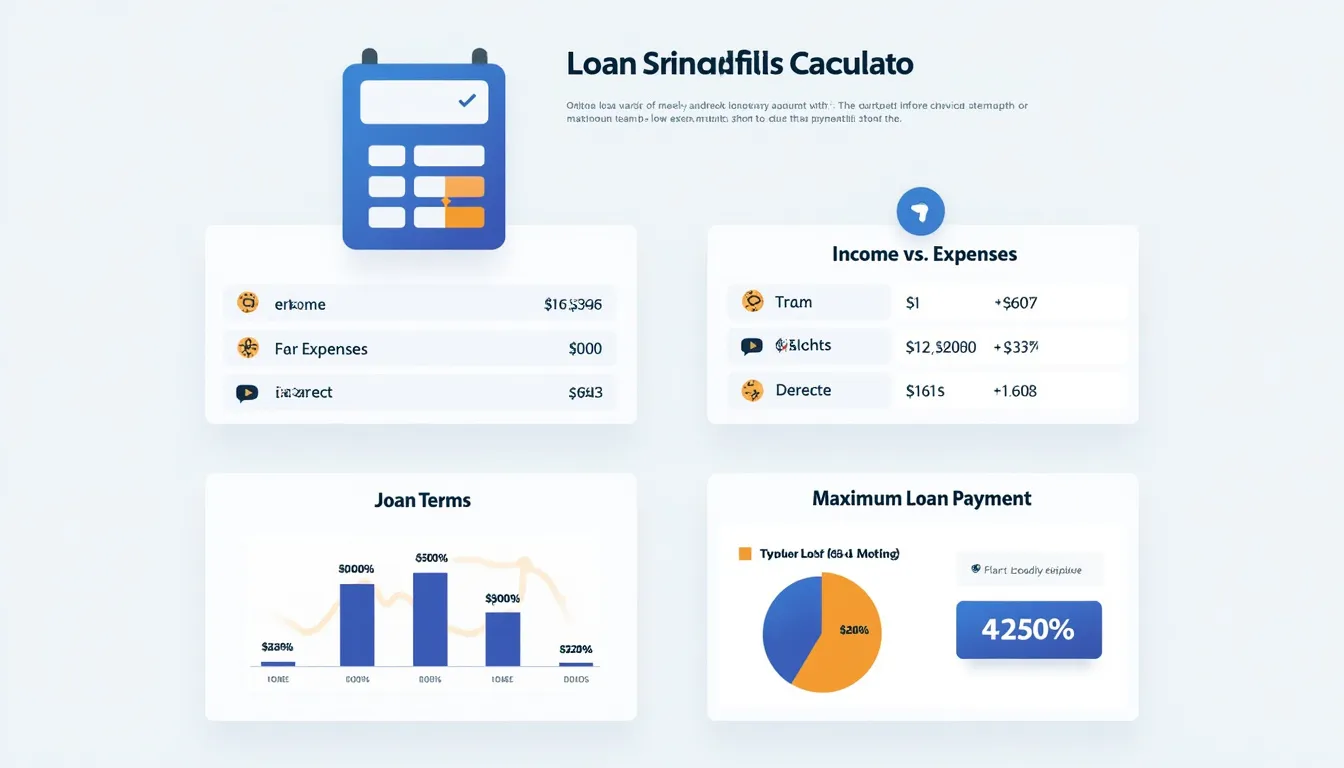Loan Affordability Calculator
Is this tool helpful?
How to use the tool
- Type your annual income: e.g., $68,500 or $112,000. Include bonuses or freelance earnings.
- Add your annual expenses: e.g., $41,200 or $57,300. Count rent, insurance, credit-card payments, etc.
- Set the loan term (months): e.g., 48 or 72. Longer terms lower each instalment but increase total interest.
- Enter the annual interest rate %: e.g., 4.8 % or 6.2 %. Use the rate in your loan offer or a current market average.
- Hit “Calculate”: the tool shows the maximum principal you can afford.
Behind the scenes: the formula
The calculator converts everything to monthly figures and applies the standard amortisation formula:
$$ \text{Max Loan} = rac{(\text{Income}/12 – \text{Expenses}/12)\,[1-(1+r)^{-n}]}{r} $$
- r = monthly rate = annual rate ÷ 12 ÷ 100.
- n = loan term in months.
Example 1
- Income $68,500 ⇒ monthly $5,708
- Expenses $41,200 ⇒ monthly $3,433
- Disposable $2,275
- Term 48 mo, rate 4.8 % ⇒ r = 0.004
- Loan factor = 1-(1+0.004)-48 = 0.171
- Max Loan = $2,275 × 0.171 ÷ 0.004 ≈ $97,200
Example 2
- Income $112,000 ⇒ monthly $9,333
- Expenses $57,300 ⇒ monthly $4,775
- Disposable $4,558
- Term 72 mo, rate 6.2 % ⇒ r = 0.00517
- Loan factor = 1-(1+0.00517)-72 = 0.299
- Max Loan = $4,558 × 0.299 ÷ 0.00517 ≈ $263,600
Quick-Facts
- Typical lender debt-to-income limit: 36 % (CFPB “DTI Ratio”, 2022).
- Average 30-year fixed mortgage rate 2023: 6.6 % (Freddie Mac PMMS, 2023).
- Federal student loan cap for undergraduates: $57,500 (U.S. Dept. of Education, 2023).
- Auto loan average term: 68 months (Experian “State of the Auto Finance Market”, 2023).
FAQ
How does the calculator differ from a lender’s approval?
It uses only your income, expenses, term, and rate. Lenders also pull credit reports, verify assets, and may add a stress-test margin (Fannie Mae Selling Guide, 2023).
Why exclude my credit score in the math?
Credit affects pricing, not your cash-flow capacity. Use a realistic rate for your score to keep the estimate meaningful (Equifax Credit Score FAQs, 2023).
What interest rate should I enter?
Insert the annual APR quoted by your lender or a market average—Freddie Mac updates a weekly survey you can reference (Freddie Mac PMMS, 2023).
Can self-employed income be used?
Yes. Average your last two years’ net income and enter that figure, mirroring lender practice (IRS Pub. 334, 2023).
How often should I recalculate affordability?
Recalculate whenever your income, expenses, or rate changes by more than 5 % to stay accurate (CFPB Budgeting Toolkit, 2022).
What happens if the formula returns $0?
Your expenses fully absorb disposable income. Trim costs or lengthen the term to improve affordability (National Foundation for Credit Counseling, 2023).
Important Disclaimer
The calculations, results, and content provided by our tools are not guaranteed to be accurate, complete, or reliable. Users are responsible for verifying and interpreting the results. Our content and tools may contain errors, biases, or inconsistencies. Do not enter personal data, sensitive information, or personally identifiable information in our web forms or tools. Such data entry violates our terms of service and may result in unauthorized disclosure to third parties. We reserve the right to save inputs and outputs from our tools for the purposes of error debugging, bias identification, and performance improvement. External companies providing AI models used in our tools may also save and process data in accordance with their own policies. By using our tools, you consent to this data collection and processing. We reserve the right to limit the usage of our tools based on current usability factors.







